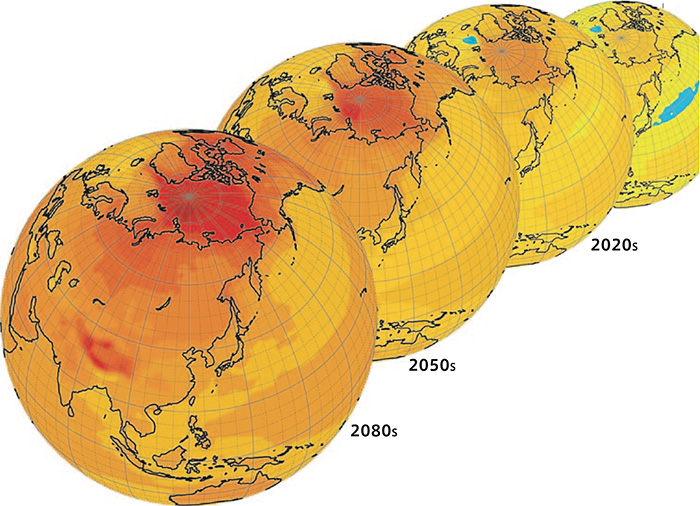Strategic Research Target ①
Understanding the mechanism of warming amplification in the Arctic
Principal Investigator: Toru Nozawa (National Institute for Environmental Studies)
Clarifying physical mechanism of the Arctic warming amplification
According to the Fourth Assessment Report (AR4) of the Intergovernmental Panel on Climate Change (IPCC), the global average surface temperature has increased by about 0.74℃ in the past 100 years (1906 to 2005). Average Arctic temperatures increased at almost twice the global average warming rate in this period. Arctic region is one of the places where the impact of climate change is the most significant in the world. The mechanism of warming amplification in the Arctic is, however, still not well understood.
When the surface temperature increases in the Arctic region, snowcovered areas, glaciers, ice sheets, and sea-ice extent retreat and therefore the surface albedo decreases, leading to further increases in the surface temperature. This ice-albedo feedback is one of the major contributors to the Arctic warming amplification. However, the ice-albedo feedback alone cannot explain the observed rapid warming in the Arctic; feedback in the atmosphere (water vapor, clouds, lapse rate, etc.), changes in permafrost and vegetation, carbon-cycle feedback, changes in atmospheric and oceanic heat transport, etc. also bring on the Arctic climate change.
In the GRENE Arctic Climate Change Research Project, we aim at elucidating the mechanism of the Arctic warming amplification by integrated analyses of the observations and numerical simulations.
Collaboration between modelling and observational studies
The following four research projects are collaboratively conducted to achieve strategic research target ① Understanding the mechanism of warming amplification in the Arctic.
(1) Improvement of coupled general circulation models based on validations of Arctic climate reproducibility and on mechanism analyses of Arctic climate change and variability
(2) Change in the terrestrial ecosystems of the pan-Arctic and effects on climate
(3) Atmospheric studies on Arctic change and its global impacts
(4) The role of Arctic cryosphere in global change
Observational research projects (2), (3) and (4) are aiming at cooperatively launching a pan-Arctic observation network including station-based and satellite-based observations. In addition to the previous observations in Siberia, Alaska, Canada, etc., comprehensive and wide-area observations will enable us to monitor and understand the overall Arctic climate changes.
Collaboration between modelling and observational studies is very important in the GRENE Arctic Climate Change Research Project. Observational data is necessary to validate and constrain the model results, and the numerical models are useful to interpret observations. We will promote close and tight communications between modelling and observational studies and implement their joint researches to achieve the strategic research target ①.
Expected results
By conducting integrated research using modelling and observations, we will quantify relative contributions of various feedback mechanisms and their interaction in the recent rapid warming in the Arctic. This would make a substantial contribution to an improvement of the coupled general circulation models, helping us to reproduce the Arctic climate changes in the past with a high degree of accuracy and reducing uncertainties in the future predictions of the Arctic warming.

Warming enhanced in the Arctic and spreading globally (Source: Toru Noawa, NIES)

